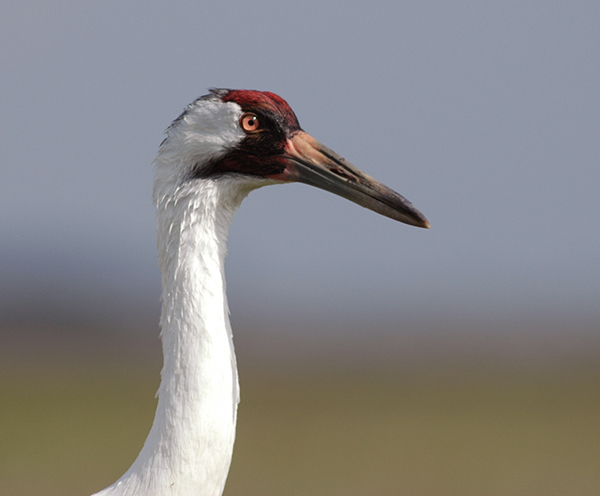
Whooping cranes have long, white wings with black tips and fly with their necks and legs extended. Their wingbeat is slower than those of white pelicans and snow geese, for which they are occasionally mistaken. Shooting fines for careless hunters often cost more than my truck. Whoopers winter in Texas from late October until April. (Photo by John Jefferson)
by John Jefferson
I began leading “Photo Safari Workshops” on the Y.O. Ranch in 1981, their centennial year. The ranch had over forty species of game from five continents. It was as close to an African photo safari as could be found in America.
I treasure those 15-years of leading workshops on the ranch. But couldn’t lead them there during fall hunting seasons. That led me to Rockport and the rare and endangered whooping cranes. I didn’t realize it at the time, but Rockport ironically played a part in the Y.O. story.
During the 1800s, Captain Shreiner bought a herd of cattle from a Rockport area rancher who branded his cattle with his initials — Y.O. — with the Y over a horizontal, oval-shaped O. Being a practical man, Captain Schreiner didn’t want to re-brand all the cattle, so he bought brand, too. That became the start of the Y.O. brand in the Hill Country
I found a man in Rockport who took sightseers to see the whooping cranes in an old boat that resembled a tugboat with a deck on top for viewing. He was an interesting old salt and looked like he might have just stepped out of Central Casting. Everyone called him Brownie. He knew where the cranes were and had an entertaining patter as we chugged across the bay to the Intracoastal Waterway. His boat was slow, but it got us there and back.
On my first check-out trip, we saw six cranes in two family groups. They even “whooped” for us. Leading a couple of trips each fall and spring, I learned more about coastal birds than ever imagined. When Brownie retired, I booked charters with several others before settling on a skipper who had ordered a larger, faster, better boat – more suitable for our needs. We toured with him for five years. When he retired, the boat was bought by Captain Tommy Moore, the current owner.
Captain Moore is highly qualified at handling the boat, identifying the birds, and respecting the weather. He also is very considerate of his passengers. The large cabin is comfortable in all conditions and has restrooms. I’ve been on his boat numerous times and never been disappointed.
It’s been rewarding seeing the whooping cranes expand from the meagre flocks that first migrated to Texas. The current population numbers 543 birds! It’s a conservation success that involved many people, including the public and most of the people taking enthusiasts to see them.
In addition to the 2,500-mile flight from Wood Buffalo Park in Canada, whoopers must dodge aircraft, fight storms, chemical spills, droughts, and careless hunters. No wonder they’re called “Rare and Endangered!”
Whooping cranes have long, white wings with black tips and fly with their necks and legs extended. Their wingbeat is slower than that of white pelicans and snow geese, for which they are occasionally mistaken. Shooting fines incurred by careless hunters costs more than my truck!
Captain Tommy Moore can be reached at 1 (361) 727-0643. Reservations are required.
JJ




